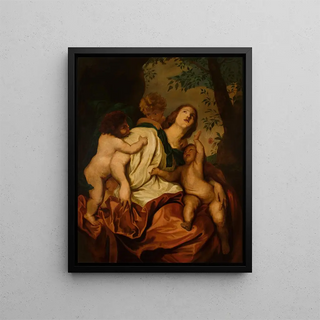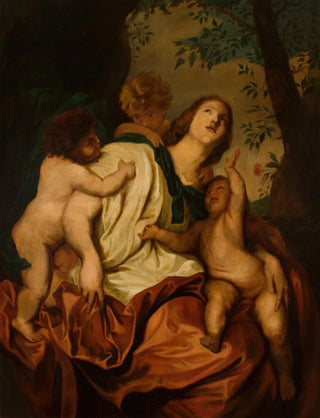Art print | Allegory of Caritas - School of Antoine van Dyck


View from behind

Frame (optional)
Reproduction Allégorie de la Caritas - École d'Antoine van Dyck – Introduction captivante
The artwork "Allégorie de la Caritas" by the School of Antoine van Dyck is a masterpiece that embodies the very essence of love and charity. This painting, rich in symbolism and emotion, immerses us in a universe where benevolence and compassion are expressed through iconic figures. In a historical context where baroque art flourished, this piece stands out for its ability to evoke deep feelings while offering a reflection on human nature. The art print Allégorie de la Caritas - École d'Antoine van Dyck allows for a new perspective on this work, providing an immersion into the universal values it conveys.
Style and uniqueness of the work
The style of the piece is characterized by mastery of light and shadow play, typical of the baroque. The figures are depicted with striking expressiveness, where each gesture and gaze seem to tell a story. The color palette, both soft and vibrant, helps create a warm, almost tangible atmosphere. The artist skillfully plays with drapery, adding a dynamic dimension to the composition. The meticulous details, from the textures of clothing to facial expressions, testify to an exceptional craftsmanship that invites prolonged contemplation. Thus, the work does not merely depict an ideal of charity; it manages to touch the viewer by inviting reflection on their own humanity.
The artist and his influence
Antoine van Dyck, a pupil of Rubens, is an emblematic figure of the 17th century, whose influence extends far beyond his era. His innovative approach to portrait painting and his ability to capture the soul of his subjects marked a turning point in art history. The School of van Dyck, to which Allégorie de la Caritas belongs, is characterized by a pursuit of beauty and harmony, while incorporating strong narrative elements. The artist inspired many contemporaries and future generations, setting high standards for the representation of the human figure. His legacy endures, and each work from this school testifies to the richness of his teachings and

Matte finish

View from behind

Frame (optional)
Reproduction Allégorie de la Caritas - École d'Antoine van Dyck – Introduction captivante
The artwork "Allégorie de la Caritas" by the School of Antoine van Dyck is a masterpiece that embodies the very essence of love and charity. This painting, rich in symbolism and emotion, immerses us in a universe where benevolence and compassion are expressed through iconic figures. In a historical context where baroque art flourished, this piece stands out for its ability to evoke deep feelings while offering a reflection on human nature. The art print Allégorie de la Caritas - École d'Antoine van Dyck allows for a new perspective on this work, providing an immersion into the universal values it conveys.
Style and uniqueness of the work
The style of the piece is characterized by mastery of light and shadow play, typical of the baroque. The figures are depicted with striking expressiveness, where each gesture and gaze seem to tell a story. The color palette, both soft and vibrant, helps create a warm, almost tangible atmosphere. The artist skillfully plays with drapery, adding a dynamic dimension to the composition. The meticulous details, from the textures of clothing to facial expressions, testify to an exceptional craftsmanship that invites prolonged contemplation. Thus, the work does not merely depict an ideal of charity; it manages to touch the viewer by inviting reflection on their own humanity.
The artist and his influence
Antoine van Dyck, a pupil of Rubens, is an emblematic figure of the 17th century, whose influence extends far beyond his era. His innovative approach to portrait painting and his ability to capture the soul of his subjects marked a turning point in art history. The School of van Dyck, to which Allégorie de la Caritas belongs, is characterized by a pursuit of beauty and harmony, while incorporating strong narrative elements. The artist inspired many contemporaries and future generations, setting high standards for the representation of the human figure. His legacy endures, and each work from this school testifies to the richness of his teachings and






